|
I was recently in a discussion where some women who had not breastfed their first child said they wanted to try to breastfeed their second child. This is a topic close to my heart as I didn't succeed in breastfeeding my eldest child, but am enjoying a great breastfeeding relationship with my second child who turned two last week. I want to pass on some of the things I learned in my journey).
Here is my TOP TEN to-do list for parents who want to succeed in breastfeeding their next baby:
Anyone else got any tips / ideas / anecdotes to pass on? I would love to hear them! (As you may have guessed, I am passionate about helping women breastfeed. I completely understand that some women can't breastfeed exclusively: but for the small minority of women who don't produce enough/any milk, I want them to know that a breastfeeding relationship is still possible - breasts are way more than just milk! And I want for EVERY woman to have the option of choosing donor milk should they wish. I have written in more detail about my breastfeeding experience here.)
0 Comments
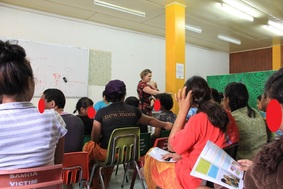 I was privileged to spend some time with some gorgeous girls in Samoa last year. As my blog posting has been sporadic-at-best as of late, this has sat in my 'drafts' way too long! Background In 2013 I was planning a family holiday to Samoa. As someone passionate about social justice, I like to ‘give back’ to the communities I live in and visit. I had helped organised an aid package to go to Samoa Victim Support Group previously, and I thought I may be able to offer a workshop to the girls at their residential shelter. Wellington-based charity SpinningTop connected me to their President Lina and we organised for me to provide a workshop for them. What I Did When we arrived in Apia I met with Lina at the SVSG offices and she gave me more background on their organisation. We discussed what I would be teaching the girls and I gave Lina a couple of boxes of supplies I had brought with me – Air NZ had kindly agreed to transport these for free. The boxes contained some donated stationery items, disposable sanitary pads donated by Kotex, as well as re-usable packs from Days For Girls NZ (containing underwear, cloth pads, and a wash cloth). I spent a morning with approximately 30 girls - the girls were fantastic and really engaged, and the staff were very supportive. The girls were gorgeous, so full of smiles and laughter. They are survivors for whom I have the utmost of respect for. Lina had told me some of their stories, and these girls have all been on traumatic and heartbreaking journeys. Most of them are with SVSG because they are survivors of sexual violence, for many of them this is incest. Many of them have been pregnant as a result of this violence. Tragically in many cases these girls have been disowned and blamed for bringing shame on the family. SVSG provides safety, education and a home for these girls. SVSG also manages the legal process to bring justice for these children. The girls had lots of questions and I felt like we could have spent a lot more time together. The level of knowledge and understanding of how their bodies work was very low. Most knew very little about the menstrual cycle, pregnancy and childbirth - despite there being pregnant girls and girls who had already birthed in the group. My (then 10 month old) daughter Nina accompanied me and I found that having her there was a good ‘icebreaker’ with the girls. The girls enjoyed chatting and playing with Nina as they warmed up to me. As it turned out Nina ended up sleeping in my front-pack for most of the morning as I taught - it was more than 30 degrees in the classroom so we were rather sweaty by the end of it! I was a little taken aback when TV cameras arrived just as we were starting. They filmed the introductory part of my session and then in the middle of the session I was called out for an interview. I was a little anxious about this as had had no warning and I wasn't sure what angle they were going to take, but I kept it very neutral and emphasised the importance of all people having a good understanding of their bodies and sexuality. It came across well on the news that night. I left SVSG feeling like what I had done that day with the girls was but a drop in the ocean. I felt like I had empowered the the girls with knowledge of their bodies, but also knew there was so much information we didn't cover. SVSG were hugely grateful for the workshop, but I wanted to do more. These girls really touched my heart. There is a huge need for ongoing body/sexuality education as well as antenatal education for the pregnant girls. SVSG has been on my mind a lot since. Looking Forward Earlier this year SpinningTop approached me to see if I would be interested in offering a more comprehensive programme for the girls at SVSG. With SpinningTop's support, I am returning to provide a one-week programme in August 2014. I am currently fundraising for supplies (food, baby formula, educational supplies) for SVSG and am hugely appreciative of any donations. For more details on this project, please click here. 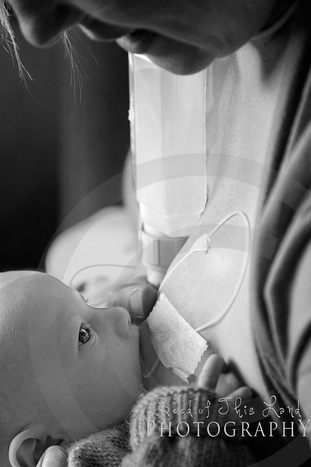 Two weeks old using an SNS. Photo by Robin Atherton. Two weeks old using an SNS. Photo by Robin Atherton. My story is part of the Blog carnival organised by World Milksharing Week, to celebrate World Milksharing Week 2013. Click here to read more stories about milksharing. If you’d like to participate too, please visit this page. When I was pregnant with my first child I learnt about how amazing breastmilk was. It’s pretty much liquid gold. I was determined to breastfeed. To my distress, things didn't go as planned. Due to many factors, my son Sol was given formula within 6 hours of birth, and although I did everything within my knowledge at the time Sol was fully formula-fed from six weeks. Failure to breastfeed long-term traumatised me on many levels. Many people didn't understand this – I was told by many “formula’s fine, he’ll be fine”, which of course it was, and he is. But this attitude undermined and invalidated my grief. Yes, formula’s “fine”, but it is not what babies were born to consume, and science indicates that the detrimental effects are numerous. (For example, it is estimated that the U.S. might save $13 billion in healthcare and other costs annually, and save over 900 babies a year if 90% if babies were exclusively breastfed for six months.) Breast isn't best, it's normal. When I was pregnant with my daughter last year I devoured every book I could find on breastfeeding. I spent a lot of time researching, understanding and finding support in my community so that I knew I had done everything I could to breastfeed my next baby. I learnt about the many things that did and did not happen in Sol’s first few days and weeks that contributed to him not being a breastfed baby. During this time I also learnt about breastmilk sharing. The World Health Organisation and UNICEF support donor human milk as the first alternative where mother's milk is not available. I decided that should I need to supplement my milk, I would do my best to find my baby human milk. Everything about Nina’s birth was wonderful (birth story here). She even did a breast crawl and latched herself on. I was in awe of her, my amazing beautiful baby. But after that first feed, I had a painful blister on my nipple. Luckily I had a fantastic midwife and she diagnosed a tongue-tie immediately. (I was later to find out Sol is also tongue-tied, which goes a long way in explaining why he never suckled and had trouble with a bottle). Thus began a journey that involved much blood (my nipples), travel (Wellington and Hamilton for Nina’s tongue laser surgery), many many sleepless nights as poor Nina tried to drink with severely restricted tongue mobility, and many many tears (hers and mine in equal parts!). By day 10 Nina had not gained enough weight and we were faced with the prospect of formula. In tears, I told my midwife that I wanted to try and find human milk for Nina. I knew the effects of non-human milk on an infant gut, and I wanted to do all I could to avoid that. My wonderful midwife fully supported this decision. I posted a request for breast milk on my local parenting group Facebook page and within 20 minutes I had offers of milk from a number of women. At that point I sat on the couch crying at the sheer generosity and amazingness of people. My husband sat with me and was similarly amazed and overwhelmed at this community of mamas. Within two hours a very special woman arrived with over a litre of breastmilk. That was a really emotional moment for me, and in fact every time we had a delivery of frozen bags of milk I got teary with gratitude. I also reached out to the Eats on Feets Aotearoa community, who were similarly incredibly supportive. A wonderful side-effect of milk sharing are the beautiful connections I made with many women. Throughout the time we were supplementing with donor milk I was worried about “nipple confusion” so I avoided using a bottle and fed Nina the donor milk through a supplementary nursing system. This had the added bonus of extra time at my breast, further stimulating my milk supply. It took 13 weeks, and my milk combined with five superstar milk-mamas until we got the tongue-tie sorted and I was able to exclusively breastfeed Nina. We’re still going strong at 11.5 months and she has still never had any formula. Going beyond the nutritional benefits of breastmilk, I feel just so grateful to have experienced the simplicity and beauty of a breastfeeding dyad. My body responding to Nina and her needs in the most simple and perfect way. Watching her eyes roll back in pure drunken happiness as the milk fills her belly is one of my life’s most beautiful moments. Now that she is older, I love her ways of communicating to me that she needs milk, and the delighted grin on her face afterwards as she toddles away. She looks round the room grinning delightedly at everyone who will look at her, as if to say “that was DELICIOUS!” People have started to ask me when we are going to stop breastfeeding. I tell them to ask Nina. She is still a huge fan, so I don’t think it will be any time soon. The World Health Organisation recommends that children are breastfed for a minimum of two years. I am immensely proud that we have made it this far together and I love the idea of full-term breastfeeding and Nina choosing when she is ready to wean. (Oddly enough I still feel anxious putting that dream out there in to the universe, as it I still can't quite believe we have made it this far!) When I was receiving donor milk for Nina, I imagined one day being able to donate my milk to other babies in need. I am not sure I ever believed that day would come. But it has, and I feel so emotional packaging up my precious packs of frozen gold, ready to nurture another baby. I am thankful for the vocal and passionate supporters of breastfeeding and breastmilk sharing. I am thankful for the oodles of research readily available showing the detrimental effects of non-human milk on babies. Knowing this meant I was that much more determined to fight the fight for Nina. I wish I had known this much when Sol was first born. I am thankful for my family and friends for their breastfeeding wisdom, support and cheerleading. I am grateful to my wonderful midwives and lactation consultants who believed in Nina and I, even when I didn’t, and gave me so much knowledge, skill and support. And most of all I am so grateful to Nina’s five Milk-Mamas who selflessly gave up their time and energy to pump their precious milk to nurture Nina. It is hard to put into words how much this meant to us. We love you! Milk-sharing absolutely epitomises the saying “it takes a village to raise a child”, and I know that Nina is growing up in one awesome village. EDIT: A few people have emailed me to ask about donating milk and how to go about doing this. If you are in a position to do this, I highly encourage you to do so. It's hard to put into words how much the donated milk meant to us, it is such a beautiful gift to give. Here are some links to check out:
Something I believe in strongly is changing the default dialogue around birthing. Perhaps it's our innate love of the dramatic, but when I was pregnant for the first time I kept hearing birth horror stories. We need to ensure that people are talking about positive birthing experiences as well. We had a wonderful home birth recently and I want to share our story, as my little part of changing that dialogue. When we learnt that I was pregnant with our much-awaited-for second child, we were ecstatic. I had had a lovely hospital birth with my son Sol (now 4.5), but I hated the hospital environment post-partum. Before this pregnancy we had decided to have a home birth and I was already excited about the birth. My siblings and I were all born at home and I grew up in a world where birth was always discussed in positive ways. I remember Mum saying on numerous occaisions that the best three days of her life were the days we were born. A close friend had attended ‘hypnobirthing’ classes and raved about them – I turned to Ms Google and what I heard sounded fascinating. Women using words such as ‘euphoric’, “pain-free” and “joyous”. These words were a far cry from the usual language associated with birth in our culture. Soon after, I was introduced to the amazing Aileen Devonshire of The Holistic Birth Company. She was happy to offer a course just for Leif and I. We spent five lovely evenings with Aileen discussing our thoughts on birthing, learning techniques for enjoying the birth and understanding what our roles were during labour and what we could do to prepare. In the latter stages of the pregnancy we set time aside to practice the relaxation and visualisation techniques. 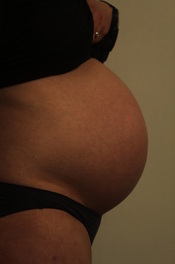 My belly in the early stages of labour. My belly in the early stages of labour. The Birth I had brought Sol home from kindergarten and just felt really exhausted. I had been working on an article that was on deadline but exhaustion washed over me and I lay down to sleep on the couch for about an hour. When I awoke at 3.45pm I continued to lie there for a few moments and then I felt a ‘pop’ of my waters breaking. In one swift movement I grabbed a towelfrom the pile of laundry beside me, threw it in the floor and rolled off the couch and on to the towel. I was impressed with myself – the towel was soaked, but not a drop anywhere else! Sol looked at me oddly, but just nodded nonchalantly when I told him my waters had broken. He’d watched numerous birth videos with me so knew what this meant. I called Leif who had just finished teaching for the day and also let my midwife Cheryl Benn know that things were underway. Sol’s birth had proceeded gradually throughout the day, so I thought I had hours to go before things really started. At this point I was having very mild contractions, spaced well apart. I was really excited but very calm, knowing everything was in place for our dream birth. I also was aware of the article I hadn't finished, so decided to get that done right away as knew that pretty soon I wouldn't have much spare time. I felt super-alert and was writing well, then all of a sudden it was like a part of my brain switched off. I decided that then was the time to email the draft to the editor and explain that was about as complete as it was going to get! 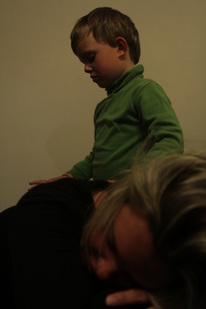 4 year old Sol helping me through contractions. 4 year old Sol helping me through contractions. Leif arrived home and started getting the room prepared. We’d instructed our baby to be born at night, and it seemed like she was going to comply. We had the fire burning and Leif hung up fairy lights and lit candles. The birthing pool was by the fire. Both grandmothers called in on their way home from work, but I had decided I wanted one last dinner together with just the three of us. After dinner I lounged over on the Swiss ball, and Sol stood beside me and rubbed my back (and occasionally climbed on me!). A really beautiful peaceful time. I realised my labour was progressing much faster than I had anticipated, so I asked Leif if he could put Sol to bed then, as I knew that pretty soon I would need all of Leif’s attention. I stayed on the swiss ball, enjoying the peace and listening to Sol’s familiar bed routine and bedtime stories. I went to kiss Sol goodnight and to make sure he knew what was happening. He had been very involved in my pregnancy and knew the drill. A few weeks earlier he had told us that he wanted to be there when the baby was being born, but he didn’t want to see her head come out. Since my waters had broken he had reminded me of this numerous times! So I was reminded of this once more, and Sol knew that when the baby was nearly being born Leif would wake him up. 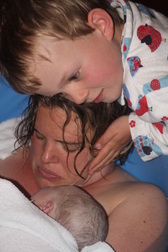 Crying with happiness! Crying with happiness! As soon as Sol was in bed it was like my body allowed my labour to progress. I continued to labour on the swiss ball while Leif started filling the pool as I felt like it wouldn’t be too long until I wanted to be weightless in the water. I usually have an active mind that is hard to quieten – I have tried meditation a number of times, but always end up sitting there with a loud chatterbox in my head. I had been concerned that that would be the case whilst birthing, however I could feel myself slipping into a really deep relaxation and became only dimly aware of what was going on in the room. Love those birthing hormones! The room was warm and cosy and lit with candles, the light of the fire and fairy lights. I recall telling Leif that it would be impossible to be stressed out in that environment! It was blissful. At about 7.30pm I got in to the pool and Mum, and my midwives Cheryl and Annie Kinloch arrived soon after. I was surprised at how fast my body was moving towards birthing and the contractions were lasting a long time and coming about every three minutes. I had a relaxation birthing CD playing and the atmosphere was just beautiful. The contractions were intense but I felt so relaxed and wonderful. I could feel our baby moving and descending and I was so overwhelmed by how perfect it was that I started crying with happiness. Notes from my midwives: 8.13pm “I can definitely feel her pushing down” 8.14pm “This is so lovely”. Rachel and Leif laughing together. 8.21pm Rachel verbalising the last contraction is beginning to give her a sense of breathing her baby out. 8.28pm Rachel moving in to a hands and knees position in birth pool. Rachel looking beautiful and feeling relaxed on endorphins. 9pm Birth pool filled deeper. Rachel semi-reclined. CD finished and Rachel enjoying the quiet. I was feeling the baby descending lower and every so often started feeling that the birth was not that far away. I continued to labour in the pool, but started feeling really exhausted. My body started feeling really heavy. My contractions had slowed a little and I decided to have Cheryl examine me. My cervix was 7cm dilated. I said that I was really tired and that I wanted to have a sleep. At about the same point in Sol’s labour I felt exactly the same way, but I was in the hospital for his birth and I recall being told that it certainly wasn’t the time for a nap! I loved my midwives when they simply responded to my request by asking where I wanted to sleep. I wanted to rest on the couch, so my lovely helpers made a bed up for me and I snuggled in, Leif sitting right beside me. It was so peaceful and quiet, and it was as if Leif and I were the only people in the house. I quickly fell into a deep relaxation, whereby I was having big beautiful dreams, then I would come back to ‘real’ for each contraction, gripping Leif’s hand tightly. Immediately following each contraction I feel back in to dreamland. It was a beautiful rest. Like being on a boat in slow-motion, the peaks and troughs of the sea movement. I stayed in this zone for about 40 minutes, and then all of a sudden was ready to continue. 10.10pm Rachel needing to get up off the couch as contractions more intense. 10.14 Back in birth pool. Rachel still feeling baby move. 10.18 “She is doing lots of kicking” 10:20 Rachel groaning through a string contraction “It’s a big opening one”. 10.51 Rachel breathing through some very pushy contractions. Rachel feeling baby moving down a bit further. I was in a deeply relaxed state, just as we had discussed with Aileen, only vaguely aware of the people in the room and just so focused on my body and it opening up to allow our daughter to be born. As I laboured in the pool I was having beautiful dreams and my body felt so powerful but so relaxed. During the classes with Aileen we had discussed the distinction between the analytical mind and the intuitive mind: with all the medical intervention in many births, we had moved so far from the intuitive mind being the dominant one in a labour. All evening my analytical mind had been switched off. Yet at this point as I drifted between dreamland and contractions, suddenly my analytical mind popped up. It was very clearly like another voice, and it is the first time I have experienced such a dichotomy within my mind. Very clearly this other voice spoke over the dreamland that I was in: “Oh my goodness Rachel, here you are, you are supposed to be having a baby, pushing a baby out, all these people are here, waiting for you to do something, and all you can do is laze about in this pool sleeping, for christs sake stop being so lazy and push this baby out!” I listened to this other voice. What the hell was I doing?! A contraction hit and suddenly my body began pushing, an all-consuming effort to PUSH this baby out. I felt my whole body contract almost involuntarily and it was a scary, out-of-control feeling. I felt the baby descend a lot and I suddenly realised I could push this baby out right there and then. I panicked, because that was certainly not what I had planned, nor what I wanted. In that split second I knew that baby could arrive right then, and it would be a painful and fast entrance and I would likely tear. I cried out to Leif to calm me down – in my memory I was screaming this in panic, but having viewed the video it wasn’t as violent as it felt. Leif did one of the relaxation exercises we had practiced and the soothing words of the midwives put me back in control and I resumed breathing and found that calm place again. 10.58 Sol woken by Leif for the birth. 11.01 Rachel supported by Leif to breathe through intense contractions. I was in a particularly deep sleep when a really intense contraction happened and I knew that our baby was nearly ready to be born. 11.07 “She is coming, I can feel her head moving down” I knew I didn’t want to rush her out and just let my body and my baby take over and let them do what they needed to do. I just kept breathing through each contraction and felt no urge to push. In my mind I could almost “see” our baby making her way out, it was such a clear vision and it really felt like she was doing it rather than me. There was no searing pain when her head emerged as I had experienced with Sol’s birth. It was such an amazing feeling as I felt more of her making her way out. I started giggling – I could feel her legs kicking inside me as they made their way down. I felt absolutely euphoric. 11.13 Rachel birthed her baby so gently in water and was caught by Leif. Leif guided baby between Rachel’s legs and Rachel lifted baby to her chest. 11.14 Baby cried. Cord loosened around neck. 11.16 Sol meeting his baby sister while being cuddled by Dad. 11.27 Baby so alert, gazing at Mum 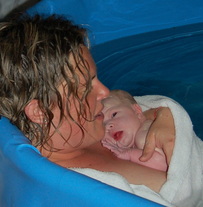 These were just amazing moments, clearly etched in my mind forever. Our little girl in my arms, surrounded by peace and love. Sol meeting his little sister for the first time. We had already decided that we would leave the cord attached as long as possible, and certainly until I had naturally birthed the placenta. 11.28 Cord still pulsating strongly 11.29 Placenta birthed 11.32 Cord clamped by Leif and cut, watched by Sol 11.40 Rachel and baby assisted out of pool. Dried and covered with warm towels. 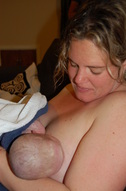 I had read about babies doing a ‘breast crawl’ immediately after birth, and wanted to give our baby that opportunity. Our little baby was placed on my chest and she immediately started snuffling round. I was mesmerised as she started inching her way to my right breast. It was so hard to resist the urge to guide her, but equally fascinating knowing she was capable of finding the nipple herself. In a very short space of time she had expertly found the nipple and started her first feast! 12.02am Baby sucking at breast after latching herself at 49 minutes old. We were all hungry so the food was brought out and we all tucked into a midnight feast round the coffee table as we chatted about the evening. A perfect, relaxing way to finish off an amazing evening. As I sat there on the couch in the comfort of my own home, with my baby suckling at my breast I was so content. Our baby slept on my chest all night and I got very little sleep, gazing at my family all snuggled in our bed together. I awoke before them all and enjoyed some moments of peace, looking at wonder at what we had created and thinking I was the luckiest person in the world. Once we had got to know her, we named our wee baby Nina Kowhai Hansen. The kowhai will always be blooming on her birthday. As soon as we found out that I was pregnant we told our three-year-old son Sol about the pregnancy and he has been involved in the midwife appointments and lots of excited talk about our new baby. He recently accompanied us to the 20-week ultrasound scan. After the radiographer had done all the important measurements and observations, she got to the least important part – finding the vulva or the penis. While she was looking for that part of our baby’s body she said to me: “Ouhhh, you’ll soon know if you’ll have to be buying a pink tutu!” (I am sure my husband smothered a laugh at this point. I refrained from launching into a tirade about gender stereotyping and the findings of various neurological studies on babies and gender.) As it turns out, we spotted a vulva. And I realised that, at 20 weeks gestation this wee girl had already experienced her first gender stereotyping. It isn’t that pink tutus violently offend me, it’s that there was an assumption that if my baby had a vulva, then a pink tutu would be the most important thing on my mind, and that her vulva would automatically predispose her to an uncontrollable urge to wear pink tutus. Who knows, she could be an absolute ballet fanatic, in which case I am sure our house will be loaded with tutus of all description. Or she could be a soccer player, a hip-hop dancer, a chess-genius, a swimmer... - in which case we may have no pink tutus at all. Or maybe she’ll have stages of being all of the above, and our already-cluttered house will have a collection of all sorts of outfits in all sorts of colours. All I know is that I will do everything in my Mama-Bear power to protect her from the tirade of gender-limiting stereotypes that I know will attempt to surround her from birth (and before!). All of a sudden I am deeply grateful on a personal level for the amazing work done to counter such attitude by individuals and organisations such as Enlighten Education, Pigtail Pals, Pink Stinks and 7Wonderlicious. And I will leave you with the wisdom of little Riley, who articulates the craziness of all this stuff just so so well: We recently had the excitement of having an ultrasound scan. I was twenty weeks pregnant and we had decided to find out the sex of our baby if he/she decided to reveal it to us.
As we walked into the room, our three-year-old son Sol announced: “I am going to see if there is a vulva or a penis!". The radiographer seemed rather uncomfortable at his confidence. She giggled, and then said to him: “A Volvo! But a Volvo is a car!”, and it seemed that she was making this joke to cover up her embarrassment at Sol’s knowledge of basic anatomy. Sol looked at her oddly, and calmly explained to her “No it’s not, it’s what girls have instead of a penis”. As I lay there, I did a silent cheer for my boy. As Sol provided a running commentary on what he believed he could see on the TV-screen of the scan, the radiographer commented to me that he had an impressive knowledge of anatomy. I thought about her comment, and I really don't think he does. I think she was actually referring to Sol's accurate labelling of sexual body parts, and I got the feeling this made her uncomfortable. Isn't it odd that so many people are so uncomfortable with the correct labelling of body parts? For preschoolers, the word vulva has about as much meaning attached to it as nose, mouth and ears. It is just another body part. As soon as we found out that I was pregnant, we told our three-year-old son Sol about my pregnancy and involved him in all the midwife appointments. He recently accompanied us to the 20-week scan. After the radiographer had done all the important measurements and observations, she got to the least important part – finding the vulva or the penis. As she was looking for that part of our baby’s body she said to me “Ouhhh, you’ll soon know if you’ll have to be buying a pink tutu!” (I am sure my husband smothered a laugh at this point. I refrained from launching into a tirade about gender stereotyping and the findings of various neurological studies on babies and gender.) As it turns out, we spotted a vulva. And I realised that, at 20 weeks gestation this wee girl had already experienced her first gender stereotyping. It isn’t that pink tutus violently offend me. It's that there was an assumption that if my baby had a vulva, then buying a pink tutu would be the most important consideration and that her vulva would automatically predispose her to an uncontrollable urge to wear pink tutus. Who knows, perhaps she will be an absolute ballet fanatic, in which case I am sure our house will be loaded with tutus of all description. Or she could be a soccer player, a hip-hop dancer, a chess-genius, a swimmer... - in which case we may have no pink tutus at all. Or maybe she’ll have stages of being all of the above, and our already cluttered house will have a collection of all sorts of outfits in all sorts of colours. All I do know is that I will do everything in my Mama-Bear power to protect my daughter from all the gender-limiting stereotypes that will attempt to smother her from birth (and before!). Suddenly I am hugely grateful on a personal level to those dedicated organisations and people who are out there campaigning on behalf of our girls - Enlighten Education, 7Wonderlicious, Pigtail Pals Ballcap Buddies, Pink Stinks and many more. I will leave you with little Riley, who articulates my feelings just so well: As soon as we knew I was pregnant, we told our son Sol and involved him in the pregnancy and the midwife appointments. He recently accompanied us to our 20 week scan.
After the radiographer had done all the important measurements and observations, she got to the least important part – finding the vulva or the penis. As she was looking for that part of our baby’s body she said to me “Ouhhh, you’ll soon know if you’ll have to be buying a pink tutu!” (I am sure my husband smothered a laugh at this point. I decided to refrain from launching into a tirade about gender stereotyping and the findings of various neurological studies on gender.) As it turns out, we spotted a vulva. And I realised that, at 20 weeks gestation this wee girl had already experienced her first gender stereotyping. It isn’t that pink tutus violently offend me, it’s that there was an assumption that if my baby had a vulva, then pink tutus would be the most important thing I would be thinking about, and that her vulva would automatically predispose her to an uncontrollable urge to wear pink tutus. Who knows, perhaps our daughter will be an absolute ballet fanatic, in which case I am sure our house will be loaded with tutus of all description. Or she could be a soccer player, a hip-hop dancer, a chess-club-member, a gymnast, a swimmer... - in which case we may have no pink tutus at all. Or maybe she’ll have stages of being all of the above, and our already cluttered home will have a collection of all sorts of outfits in all sorts of colours. The only thing I do know is that I will be doing everything in my Mama-Bear power to shelter our daughter from all the gender-limiting stereotypes all too persuasive in our culture. And I am grateful to the amazing people who campaign so hard on these issues - Enlighten Education, Pigtail Pals Ballcap Buddies, 7Wonderlicious and so many more. |
AuthorRachel is a writer and educator whose fields of interest include sexuality education, gender, feminism and youth development. Archives
November 2023
Categories
All
|

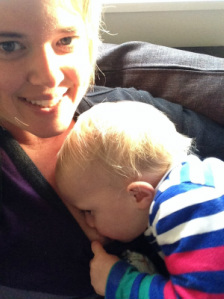
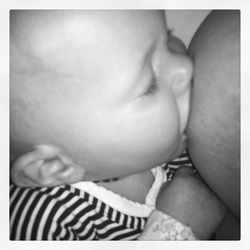
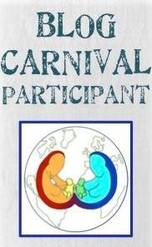
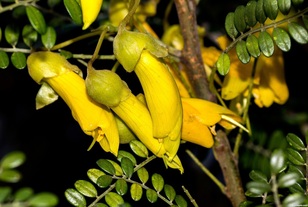
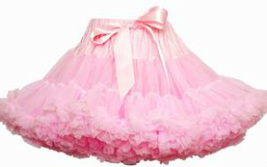
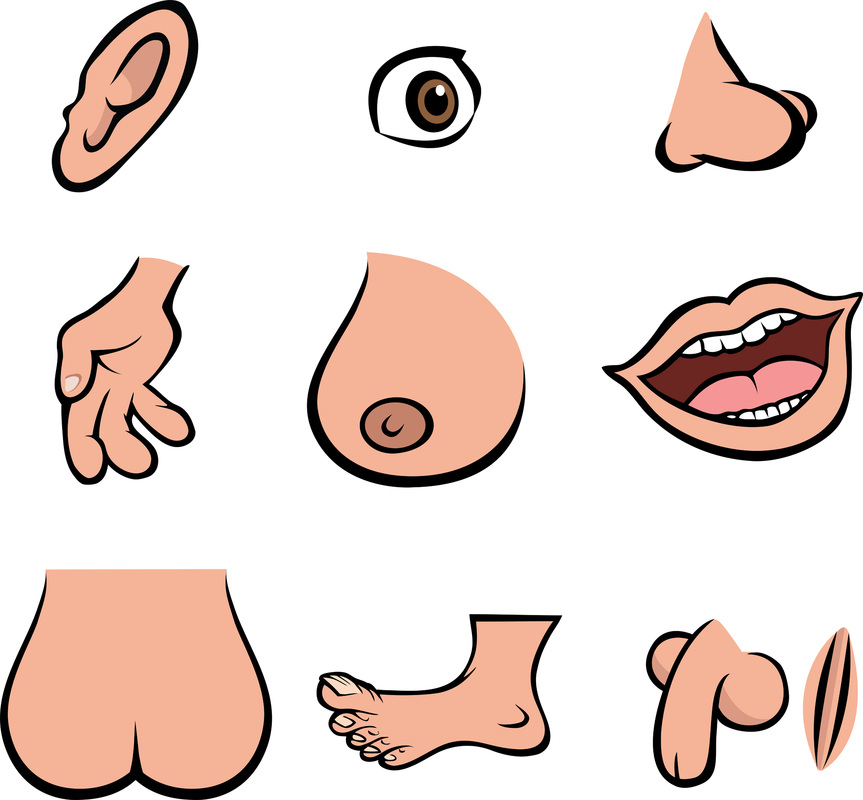
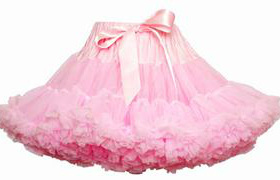
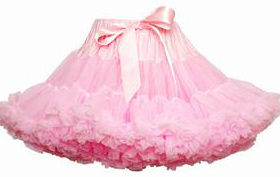
 RSS Feed
RSS Feed




